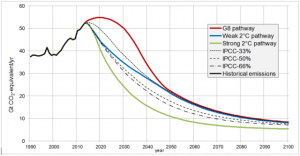David Victor and Charles Kennel write in a recent commentary published by Nature “Politically and scientifically, the 2 °C goal is wrong-headed.” Their commentary has prompted a number of responses – see article in The Guardian by Adam Vaughan and rebuttals by Gavin Schmidt, Bill Hare and others, and Joe Romm.
Victor and Kennel argue that the 2 °C limit suffers from two political problems. First, they assert, keeping below 2 °C is unachievable without “heroic assumptions” about immediate global cooperation and widespread availability of technologies that have not been demonstrated at scale. Second, the 2 °C threshold does not translate into a specific and certain quantity of emissions, and therefore “does not tell particular governments and people what to do.”
Scientifically, the basis for the 2 °C limit, according to Victor and Kennel, is tenuous, in part because changes in average global surface temperature does not track in lock step with climate forcing and climate risks on short time scales. They take the position that a single index of climate change risk is not possible given the complexities of how changes in carbon dioxide concentrations alter climate and other earth systems, and the consequent risks to ecological systems and humans. They advocate for development of a set of indicators, or “planetary vital signs,” to be used by policy makers and the UNFCCC to gauge climate stresses and possible impacts that are “better rooted in the scientific understanding of climate drivers and risks.”
Gavin Schmidt, director of NASA’s Goddard Institute for Space Studies, wrote an excellent rejoinder in Realclimate. He also posted a comment to an article in The Guardian about the Victor-Kennel commentary that nicely matches my take: “If you are driving in completely the wrong direction, arguing about where you’ll park if you arrive isn’t your highest priority.” I have significant doubts about the viability of reaching a comprehensive, top-down, legally binding agreement at COP21 in Paris. But urging parties to the UNFCCC to revisit the hard-won agreement to try to limit warming to < 2 °C, and consider replacing it with targets for an array of planetary vital signs, is an invitation to inaction that would have dangerous repercussions.
Do read Gavin Schmidt’s more detailed assessment of why the 2 °C limit should not be ditched. He makes a good case for the scientific validity for using average global temperature as a reasonable indicator of climate risk, and counters the assertion that the 2 °C limit is technically or economically unachievable.

